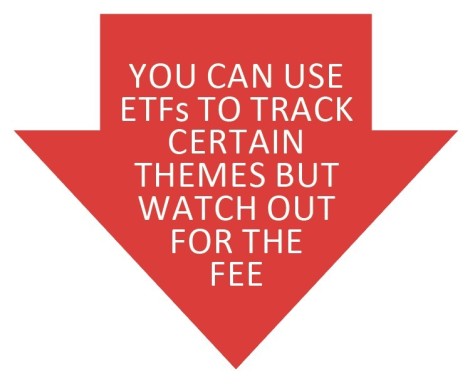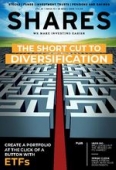Archived article
Please note that tax, investment, pension and ISA rules can change and the information and any views contained in this article may now be inaccurate.
The short cut to diversification

Low cost, instant to trade and easy to understand – it’s no wonder that exchange-traded funds are becoming increasingly popular with investors.
Also known as ETFs or trackers, these low-cost investments are designed to mimic the performance of a given stock market or sector. But as ETFs have grown in popularity and assets under management have swelled, so too has the array of different things you can do with them.
They can be an ideal solution as building blocks of a diversified portfolio, allowing you to gain exposure to hundreds of underlying investments at the click of a button.
Once known almost entirely as being a simple way to track a popular index such as the FTSE 100 or the S&P 500, investors can now use ETFs to tap into specific industries, niche themes or particular trends such as value or momentum. But, just as with any other investment, it is important to do your homework first.
BROAD AND BASIC
ETFs have a number of appealing characteristics for investors. First and foremost, they are cheap and prices have fallen further in recent years as competition in the market has increased and technology has enabled fund groups to create new products more easily.
It is now possible to invest in an ETF for less than 0.05% - or under 50p on a £1,000 investment. That compares with a typical fee of around 0.75% for an actively managed fund.
ETFs are listed on an exchange and bought and sold like company shares; that means investors don’t have to wait until dealing at the end of the day to buy or sell their investment, it happens at any point throughout the day.
ETFs are perhaps best known for their ability to track particular stock markets. Investors can choose funds that mirror the performance of the FTSE 100, S&P 500 or MSCI Emerging Markets index and enjoy exposure to the entire stock market or region through one product.
Among the cheapest ETFs tracking the UK market is Lyxor Core Morningstar UK (LCUK) which charges just 0.04%. It is designed to track a basket of large and mid-cap London-listed firms representing 97% of the total value of the UK market. ETFs track an index either by buying shares in all of the companies on that market or by investing in a representative sample of them if the universe is particularly big. Investors don’t have to just track a country or region either; ETFs can track entire sectors such as technology or consumer staples.
ETFs track an index either by buying shares in all of the companies on that market or by investing in a representative sample of them if the universe is particularly big. Investors don’t have to just track a country or region either; ETFs can track entire sectors such as technology or consumer staples.
Using ETFs to access these markets has been a popular strategy with investors in recent years because they are broad and contain hundreds of stocks. The alternative of cherry-picking individual stocks within these markets can be both risky and expensive, and outperforming the index can be difficult to achieve even for professional investors, particularly at a time when stock markets are generally rising.
James Norton, senior investment planner at Vanguard, says: ‘Investing should be about the market at a broad level and not trying to single out the best funds or stocks because the chances are you won’t be able to. Outperforming in a particular market is difficult so it is often better to be as broad as you can, for example investing in the entire Emerging Markets index rather than just China or India.’
THEMATIC
ETFs that tap into specific themes can look very exciting; they allow investors to narrow down trends they believe will do well over the long term and hone in on businesses in potentially very niche industries or those which look best placed to benefit from a structural change in the world.
But there is a danger here that investors can end up putting their money in a tracker whose focus is so niche that it becomes risky.
Rob Powell, lead strategist at iShares Thematic Investing, says: ‘A thematic approach allows investors to take a different view of the world, drawing together companies based upon trends that we can see around us and the impact they’re likely to have in the future.’
Some of the themes that iShares has identified include technological breakthroughs, rapid urbanisation and the rise of electric cars.
The number of thematic ETFs has grown rapidly in recent years and investors can now choose to back specific trends from timber to water and robotics to renewable energy. There are funds which only invest in firms with good gender equality standards and even ones which focus solely on pet care businesses.
The issue is that some of these themes have a limited number of investable listed businesses within them, meaning that these funds can end up being concentrated into just a handful of stocks, which can make performance volatile.
ETFs tracking smaller markets or specific themes can also be more expensive. The Ossiam ESG Low Carbon Shiller ETF (5HED), for example, has an ongoing charge of 0.85%. It tracks companies with a lower carbon footprint and good economic, social and governance (ESG) practices.
Adam Laird, head of ETF Strategy at Lyxor, says: ‘There are some areas which have the potential for outperformance but you need to be careful. In technology, for example, many of the ETFs will be dominated by the same tech giants and a lot of the most exciting companies are unlisted so can’t be bought by a fund.’
As a result, with specific themes it may be better to gain access through a specialist fund where the manager has proven expertise in finding investment opportunities within the industry and may have the ability to invest in unquoted businesses.
Norton says: ‘We don’t particularly believe in ETFs which focus on these micro-sectors. It comes back to diversification; doing well in a specific sector is hard and it is usually better to be as broad as possible in your exposure when investing.’
He adds: ‘That said, I think as long as the core of your portfolio is well-allocated then having exposure to specific areas around the edges doesn’t matter as long as you do your research and know what you are investing in. Flavour of the month products can be expensive and prone to large fall when they fall out of favour.’
ASSET CLASSES
ETFs can be used for tracking more than just equities. A number of these funds allow investors to focus on specific asset classes such as bonds or property.
It is also possible to track commodities using exchange-traded funds – one example being iShares Diversified Commodity Swap (ICOM) which offers exposure to a portfolio of commodity contracts from seven different sectors for an ongoing charge of 0.19%.
Products which track individual commodities are not strictly speaking ETFs as they do not meet diversification requirements and instead are exchange-traded products (sometimes called exchange-traded commodities).
Among the most popular assets for investors to track are gold and oil, because getting direct exposure to the price of these commodities is otherwise difficult. The downside of tracking the spot price of assets such as these is that they can be volatile. Some funds will also use derivatives to track the asset, because they can’t physically hold oil, for example, which can be complicated and add to the cost.
Another nuance to watch out for is which currency the index is being tracked in as often these commodities are priced in dollars rather than sterling, which means your returns can be influenced by the exchange rate between currencies.
With asset-based ETFs it is important to understand what the fund is actually buying. With bonds, for example, a fund will likely invest in a sample rather than all of the bonds in a given index simply because there are so many to choose from. In this case, paying close attention to the credit-quality and durations of the bonds being chosen will be an important indicator of the yield you can expect to receive.
The bond market is so vast that investors can either take a very broad approach with, for example, the Xtrackers II Global Government Bond ETF (XG75), which holds bonds across the US, France and Japan among other countries, or be very specific through funds such as the iShares Italy Government Bond ETF (IITB), which focuses on just one country and one type of debt.
Property ETFs, meanwhile, are unlikely to invest in actual bricks and mortar but may instead give access to either housebuilders and construction companies or to real estate investment trusts. The iShares UK Property ETF (IUKP) holds the shares of British property groups Segro (SGRO), British Land (BLND) and Land Securities (LAND) while the SPDR Dow Jones Global Real Estate ETF (GBRE) invests in the likes of US mall operator Simon Property Group and warehouse and logistics property group Prologis.
The benefit to investing in real estate investment trusts in this way is that you can get low cost exposure to a number of different vehicles, but the downside is that they can be quite closely correlated and performance can be volatile, such as after the EU referendum in 2016 when the share prices of property trusts fell as much as 70% in some cases.
RULE-BASED ETFS
As the technology underpinning them becomes more sophisticated, ETFs have been able to offer more complicated strategies to investors. While these funds have typically been known for passively following a particular index or stock market, rule-based or smart beta ETFs have more specific criteria. Laird explains: ‘Once upon a time, if you wanted income shares or to focus on value companies you had to choose an active manager, but now ETFs can do the same job and often at a fraction of the cost.’
Laird explains: ‘Once upon a time, if you wanted income shares or to focus on value companies you had to choose an active manager, but now ETFs can do the same job and often at a fraction of the cost.’
Rules-based ETFs offer options to invest in high-yielding companies, momentum stocks or value investments. When choosing these it is important to look at how exactly the fund selects its holdings and how these are monitored – momentum stocks, for example, change frequently so need to be closely tracked – as well as assessing the track record of the fund and its parent company’s experience in the sector.
The SPDR UK Dividend Aristocrats ETF (UKDV), for example, focuses on the 40 highest-yielding UK companies within a broader index, including BT (BT.A), Greene King (GNK) and Tate & Lyle (TATE). It yields around 4.1%. Meanwhile, the iShares MSCI World Quality Dividend ETF (WQDV) holds quality income-paying firms across the globe including Exxon Mobil and Nestle in Europe and Verizon and Cisco Systems in the US. It yields 3%.
Other ETFs use leverage – meaning they borrow money – with the aim of maximising gains, but the risk here is that the leverage will also magnify any losses. Meanwhile, inverse ETFs use derivatives to take short positions, betting against the market, which may appeal to those who believe the stock market is due a correction but returns will suffer in a rising market.
Costs can be higher in these areas too because the investments are more complicated to create and may require more oversight than other ETFs.
A key measure to watch out for is the spread – this is the difference between the price you buy at and sell at, and if there is a wide gap between the two could signal that the investment could be more difficult to sell when you want to. Larger funds, with more assets under management, may be more liquid and therefore have tighter spreads.
Norton adds: ‘Smart ETFs are a really interesting area but some of these funds, which use leverage or swaps, may be potentially dangerous and are more akin to gambling than investing.’
Important information:
These articles are provided by Shares magazine which is published by AJ Bell Media, a part of AJ Bell. Shares is not written by AJ Bell.
Shares is provided for your general information and use and is not a personal recommendation to invest. It is not intended to be relied upon by you in making or not making any investment decisions. The investments referred to in these articles will not be suitable for all investors. If in doubt please seek appropriate independent financial advice.
Investors acting on the information in these articles do so at their own risk and AJ Bell Media and its staff do not accept liability for losses suffered by investors as a result of their investment decisions.

 magazine
magazine













